Yesterday's Tomorrows: Eight Contemporary Classics
by Graham Sleight
from Locus Magazine, December 2007
Blood Music, Greg Bear (Arbor House 0-87795-720-7, $14.95, 262pp, hc) 1985. Cover by Frances Jetter. (Gollancz 978-0-575-08109-3, £7.99, 245pp, tp) 2007.
Evolution, Stephen Baxter (Gollancz 0-575-07341-1, £18.99, 585pp, hc) 2002. (Gollancz 978-0-575-08113-0, £7.99, 662pp, tp) 2007.
The Separation, Christopher Priest (Scribner UK 0-743-03836-6, £17.99, 464pp, hc) 2002. (Gollancz 978-0-575-08115-4, £7.99, 376pp, tp) 2007.
Schild's Ladder, Greg Egan (Gollancz 0-575-07068-4, £16.99, 248pp, hc) 2002. Cover by blacksheep. (Gollancz 978-0-575-08111-6, £7.99, 284pp, tp) 2007.
Altered Carbon, Richard Morgan (Gollancz 0-575-07321-7, £17.99, 404pp, hc) 2002. Cover by Chris Moore. (Gollancz 978-0-575-08112-3, £7.99, 474pp, tp) 2007.
Hyperion, Dan Simmons (Doubleday 0-385-24949-7, $18.95, 482pp, tp) 1989. Cover by Gary Ruddell.(Gollancz 978-0-575-08114-7, £7.99, 470pp, tp) 2007.
Revelation Space, Alastair Reynolds (Gollancz 0-575-06875-2, £17.99, 476pp, hc) 2000. Cover by Chris Moore. (Gollancz 978-0-75288-905-5, £7.99, 587pp, tp) 2007.
Fairyland, Paul J. McAuley (Gollancz 0-575-06070-0, £16.99, 336pp, tp) 1995. Cover by Steve Crisp. (Gollancz 978-0-575-08110-9, £7.99, 374pp, tp) 2007.
Here's the British playwright Alan Bennett, ending his review of John Osborne's autobiography A Better Class of Person: "It constantly brings to life that remotest of periods, the recent past." I know what he means. For the 18 months I've been writing this column, I've talked almost exclusively about books published before I started reading SF, and often about books published before I was born. I've been trying to articulate how good or dated they seem, what allowances a contemporary reader has to make, and how they've become canonical within SF. This time, I want to do something a little different: to look at some more recent novels that seem to be becoming canonical, and ask similar questions. It feels (at least to me) a far more complicated task. An author like Heinlein is absorbed into the bloodstream of SF. It's not quite that he's been normalised — some of his books, like Starship Troopers, are so deliberately ornery that they probably won't ever be. But someone writing in a similar tradition now — John Scalzi, say — is doing so in relation to works that are fixed. If nothing else, the author isn't around any more to amend his body of work. Whereas all the books I want to look at this time are by living authors, and some of the books are no more than five years old.
The occasion for all this is the reissue, by Gollancz in the UK, of eight of their backlist titles as "Future Classics." The books are arrestingly designed, to a fault. (They don't carry either the author or the title on the cover, using instead semi-abstract designs, often with no strong link to the content of the book. If the Locus layout wizards do their usual thing and reproduce all eight covers here, you can have fun trying to figure out which is which.) The oldest dates from 1985, the newest from 2002. Five are by British authors, two by Americans, one by an Australian. None are women.
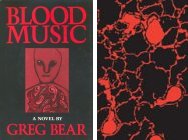 Looking at the eight books, the questions that arise are in some ways the same as for Heinlein or Bradbury. Are they "dated," and do we have to make allowances for them? The answer is emphatically no for Greg Bear's Blood Music (1985). It's the simplest of all of them in plot: researcher creates DNA-altering virus in California lab, injects himself, infects the rest of humanity, transcendence ensues. The exposition is frontloaded into the first few chapters as the researcher, Vergil Ulam, gets progressively alienated from Genetron, the company where he works. So far as I can paraphrase the science — not very far — the first argument Blood Music puts forward is that our DNA is a language that can be spoken to and with. Vergil's virus stimulates, in the first instance, an intelligent restructuring of his own body. There's a fine scene where he has a medical exam and baffles the observer and his computer: it looks like his spine has suffered massive trauma, but it is in fact better functioning than ever.
Looking at the eight books, the questions that arise are in some ways the same as for Heinlein or Bradbury. Are they "dated," and do we have to make allowances for them? The answer is emphatically no for Greg Bear's Blood Music (1985). It's the simplest of all of them in plot: researcher creates DNA-altering virus in California lab, injects himself, infects the rest of humanity, transcendence ensues. The exposition is frontloaded into the first few chapters as the researcher, Vergil Ulam, gets progressively alienated from Genetron, the company where he works. So far as I can paraphrase the science — not very far — the first argument Blood Music puts forward is that our DNA is a language that can be spoken to and with. Vergil's virus stimulates, in the first instance, an intelligent restructuring of his own body. There's a fine scene where he has a medical exam and baffles the observer and his computer: it looks like his spine has suffered massive trauma, but it is in fact better functioning than ever.
But Bear's second argument is that this change, once set in motion, can't be stopped. The tool to remake humanity's DNA is, by definition, a self-reproducing and intelligent one, and will necessarily outpace any attempts to stop it. So much of the second half of the book is given over to a kaleidoscope of perspectives on the world-altering shifts it engenders. Some of these are more effective than others. I wasn't so convinced by the adventures of Suzy McKenzie, a young woman wandering round a deserted New York: her story seemed too similar to many other cosy catastrophes I'd read. But another chapter, the transcript of an aerial reconnaissance mission over a North America transformed by the virus, is superb, as pure a rendering as I can imagine of what it would be like to witness the utterly strange.
The third argument of Blood Music is that beyond a certain point, alterations in humanity and its now collective consciousness will create alterations in the deep structure of reality. Bear is fuzzy about why this will happen, and frankly I don't believe him. But by the point in the book where this prospect is on the table, Bear has built up such a head of steam that you just follow him. The transcendence that follows has, as many readers have noted, an obvious kinship with Arthur C. Clarke's Childhood's End (1953). But Bear asks further questions about what it would be like to live inside such a singularity. In doing so, he provides an earned "happily ever after" ending, aesthetically (if not logically) the only place the story could end. Notwithstanding such formidable later novels as Eon (1985) and Queen of Angels (1990), this still seems to me Bear's most complete and satisfying work.
One of the interesting tensions in Bear's work is between the American and British strains of SF. Broadly (and here I'm borrowing from Brian Stableford's The Scientific Romance in Britain (1985)), British SF derives from the scientific romance tradition of Wells and Stapledon, in which protagonists observe (often in wonder) but do not change the world. In American SF, they do, and the future is something to be worked on, conquered, perhaps owned. The difference, therefore, is agency: how much the characters do, and how much change their actions effect. In Blood Music, arguably, only one action really matters: Vergil injecting himself with the virus. Everything else is just playing out the consequences of that action.
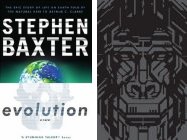 Stephen Baxter's Evolution (2002) is a pure example of latter-day scientific romance, which provides a panorama across life on Earth from 65 million years ago to the present, and then (briefly) the future. The viewpoint is omniscient, the tone calm: "The turtles, ancient, had already passed the zenith of their diversity. But where more spectacular creatures had perished en masse, the turtle had survived. In a dangerous world, humility made for longevity." Individual actions are important in their context, but are subsumed in far huger trends.
Stephen Baxter's Evolution (2002) is a pure example of latter-day scientific romance, which provides a panorama across life on Earth from 65 million years ago to the present, and then (briefly) the future. The viewpoint is omniscient, the tone calm: "The turtles, ancient, had already passed the zenith of their diversity. But where more spectacular creatures had perished en masse, the turtle had survived. In a dangerous world, humility made for longevity." Individual actions are important in their context, but are subsumed in far huger trends.
A book like Evolution is, among other things, a powerful argument for saying that you can't read SF novels in the same way that you would Jane Austen or William Faulkner. There are characters in it, to be sure, but differentiating them or representing the delicacies of their emotional responses is not the point. The enjoyment you get from it is more like what you get from watching a really good nature documentary. When Baxter follows the stories of his turtles or primates, he's putting the lightest cladding of story on a scaffolding of research. What's remarkable is how successful Evolution is, how much one doesn't mind its inevitable didacticism. Baxter's tone, with its echoes of Clarke and Stapledon, is a great help here. About halfway through the book, Baxter is talking about early toolmakers:
Each lump of flint was a miniature cemetery. In some long-vanished sea the corpses of crustacean shells had settled into sediment, and minute glassy needles that had once formed the skeletons of sponges became the nuggets of flint embedded inside the gathering chalk seams.
By that point, of course, we've spent time in those seas with those crustaceans, and it's a sobering shock that even at this point, millennia before the current day, human endeavour is founded so intimately on the past.
 There's a different take on the past, and on agency, in Christopher Priest's alternate history The Separation (2002). Some of the Future Classics were new to me, but this was the third or fourth time I've read The Separation. This time around, I was less impressed than I had been before by its central argument, that a peace with Hitler after 1941 would not have produced as disastrous an outcome as we might suppose. The book follows the twins Jack and Joe Sawyer, one seemingly embedded in our universe, one in another wherein a peace is made in 1941. Perhaps my experience was skewed by having recently re-read Philip K Dick's The Man in the High Castle (1962), in the new Library of America omnibus. Like Dick, Priest clearly delved deeply into the bones of World War II. But although Dick's novel takes place many miles from the European heart of Nazism, you never have the sense — as you do sometimes with Priest — that he's scanting on describing the evil it embodied.
There's a different take on the past, and on agency, in Christopher Priest's alternate history The Separation (2002). Some of the Future Classics were new to me, but this was the third or fourth time I've read The Separation. This time around, I was less impressed than I had been before by its central argument, that a peace with Hitler after 1941 would not have produced as disastrous an outcome as we might suppose. The book follows the twins Jack and Joe Sawyer, one seemingly embedded in our universe, one in another wherein a peace is made in 1941. Perhaps my experience was skewed by having recently re-read Philip K Dick's The Man in the High Castle (1962), in the new Library of America omnibus. Like Dick, Priest clearly delved deeply into the bones of World War II. But although Dick's novel takes place many miles from the European heart of Nazism, you never have the sense — as you do sometimes with Priest — that he's scanting on describing the evil it embodied.
I think this is because Priest, as I said, is presenting an argument; and in order to do that, he marshals the evidence to support him. This is a long way from the multiplicity of perspectives that Dick presents. Instead, we have the lives of Joe and Jack Sawyer relayed through their journals and other official documents, so that the crucial moment of decision is an abbreviated minute of a cabinet meeting. There, "J.L. Sawyer," as a Red Cross representative, argues the pacifist case against war: that it is always illegitimate, that it never produces the outcome desired, that violence in itself is so wrong that it should not be countenanced. He wins the argument, and the deaths of millions are avoided.
So Priest's novel pivots on a single decision, but it feels like a trapped decision: a judge summing up in favour of one side, but telling the jury it's a matter for them. That's not to diminish the skill with which Priest tells the story, or the readability he gives the book. If anything, my admiration for his technical facility increased this time round. Each of the documents making up the book feels authentic, and justified in its own right, as well as for the place it takes in the larger story. And if Priest's intent was to make people think again about World War II, he's succeeded; he's just not succeeded at getting me to agree with him.
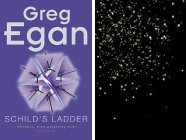 After this, it was something of a shock to run into Greg Egan's Schild's Ladder (2001), the only book in the Future Classics series whose presence I really question. Normally, I have a very high regard for Egan's work, especially his short fiction. But this for me is the book where his cosmological speculations become so abstract (almost aggressively abstract) that there are many SF fans I'd hesitate to give it to, let alone someone new to the genre. In a sense, the story is very similar to that of Blood Music: a scientific experiment has unexpected consequences, and most of the book is devoted to seeing if they can be unpicked. Except that in Schild's Ladder, the experiment is in "quantum graph theory," and creates an expanding area of the universe with different physical laws. Inside this area, it transpires, new forms of life are created; the central debate of the book is how and whether the two areas might communicate.
After this, it was something of a shock to run into Greg Egan's Schild's Ladder (2001), the only book in the Future Classics series whose presence I really question. Normally, I have a very high regard for Egan's work, especially his short fiction. But this for me is the book where his cosmological speculations become so abstract (almost aggressively abstract) that there are many SF fans I'd hesitate to give it to, let alone someone new to the genre. In a sense, the story is very similar to that of Blood Music: a scientific experiment has unexpected consequences, and most of the book is devoted to seeing if they can be unpicked. Except that in Schild's Ladder, the experiment is in "quantum graph theory," and creates an expanding area of the universe with different physical laws. Inside this area, it transpires, new forms of life are created; the central debate of the book is how and whether the two areas might communicate.
Part of the problem is that Egan's characters are so far removed from us and our concerns that it's difficult to find empathy for them. This need not be a terminal problem, as he's given us plenty of fine stories which feature characters in radically different situations to the present-day world. More pressing, I think, is the level of scientific knowledge needed to follow what's going on. Without wanting to grandstand, I'm the possessor of a rusty but by no means disused university education in mathematics, and I doubt if I followed Egan's science more than half the time. The first chapter alone has such a density of speculation about graphs, nodes, quantum theory, and cosmology that I might well have given up on the book if I hadn't been reviewing it. That would have been a shame, since those of Egan's speculations I can follow — for instance on what life would be like in the new zone of the universe — embody very striking images.
As I say, the choice of Schild's Ladder seems odd to me on many levels, especially since Egan's back catalogue contains works which combine human stories and more accessible science. Either, say, Teranesia or Distress would have been more understandable choices. But as it stands, this weird novel feels like a scientific romance aimed at the highest level of scientists.
 It'd be difficult to think of a greater contrast to the chilly, cerebral Egan than Richard Morgan's first novel Altered Carbon (2001). Fast, garish, kinetic, and violent, it demonstrates how far British SF has come since the days of the scientific romance. The story follows the mercenary Takeshi Kovacs through a 26th-century future for which "brutal" seems too polite an adjective. Some of the SFnal speculation is new, and some just feels new, but what matters is the energy with which Morgan presents it all. A concept like "sleeving" — being able to dump a consciousness into a new body — doubtless has many antecedents, but you're onto the next idea before you have chance to breathe.
It'd be difficult to think of a greater contrast to the chilly, cerebral Egan than Richard Morgan's first novel Altered Carbon (2001). Fast, garish, kinetic, and violent, it demonstrates how far British SF has come since the days of the scientific romance. The story follows the mercenary Takeshi Kovacs through a 26th-century future for which "brutal" seems too polite an adjective. Some of the SFnal speculation is new, and some just feels new, but what matters is the energy with which Morgan presents it all. A concept like "sleeving" — being able to dump a consciousness into a new body — doubtless has many antecedents, but you're onto the next idea before you have chance to breathe.
If I have a problem with the novel, it's with the brutality, the extent and the severity of the violence it depicts. Morgan's response would doubtless be that he sees the world heading in this direction (accelerated by sleeving), and that he has a duty to depict it fully. He puts the opposite point of view into the mouth of one of Kovacs's antagonists towards the end of the book:
"I was young and stupid," [Kovacs] said simply. "I was used. I killed for people like you because I knew no better. Then I learnt better. What happened at Innenin taught me better. Now, I don't kill for anyone but myself, and every time that I take a life, I know the value of it."
"The value of it. The value of a human life." Kawahara shook her head like a teacher with an exasperating student. "You are still young and stupid. Human life has no value. Haven't you learned that yet, Takeshi, with all you've seen? It has no value, intrinsic to itself. Machines cost money to build. Raw materials cost money to extract. But people?" She made a tiny spitting sound. "You can always get some more people, whether you want them or not. They are abundant, Takeshi. Why should they be valuable?"
That's all very well as a portrait of capitalism: a particular kind of capitalism, extrapolated far beyond the level it's at presently. And Kovacs's story, as a servant of this worldview who learns better, is well told. But I can't help feeling that Altered Carbon is a book that wants to have its cake and eat it: that it enjoys the guns, the explosions, the exercise of power while at the same time condemning them.
(I should add that of all the books I'm looking at, it's the one with the most obvious detail that will date it: people smoke cigarettes, and sometimes they don't even feel guilty about it. Wherever you stand on the public health versus individual liberties argument on smoking, it's hard to imagine this particular noir emblem will persist five centuries from now.)
 It seems worth considering the next two books together: Dan Simmons's Hyperion (1989) and Alastair Reynolds's Revelation Space (2000). Both are bulky space operas, both are the start of a series, both have multiple plot-lines running through them. Yet they couldn't be more different. I first read Hyperion more or less when it came out, and remember thinking that it was an almost perfect reading experience, a demonstration of how great the possibilities of space opera were. This time around, I wasn't quite so impressed perhaps partly because I've read the rest of the sequence and know which surprises Simmons was withholding here. But it's still an amazingly readable book. It follows seven pilgrims as they make their way to a planet called Hyperion, whose "Time Tombs" are watched over by a mysterious and deadly creature called the Shrike. As they travel, they tell each other their stories, Chaucer-fashion; it turns out that they've all had encounters with both the planet and the Shrike before. These stories work as little samplers of SF's subgenres: military SF in the Soldier's Tale, cyberpunk in The Detective's Tale, and so on. In the process, they outline Simmons's far-future world, one held together by a "human hegemony", and governed more than anything else by the availability of matter transmitters or "farcasters."
It seems worth considering the next two books together: Dan Simmons's Hyperion (1989) and Alastair Reynolds's Revelation Space (2000). Both are bulky space operas, both are the start of a series, both have multiple plot-lines running through them. Yet they couldn't be more different. I first read Hyperion more or less when it came out, and remember thinking that it was an almost perfect reading experience, a demonstration of how great the possibilities of space opera were. This time around, I wasn't quite so impressed perhaps partly because I've read the rest of the sequence and know which surprises Simmons was withholding here. But it's still an amazingly readable book. It follows seven pilgrims as they make their way to a planet called Hyperion, whose "Time Tombs" are watched over by a mysterious and deadly creature called the Shrike. As they travel, they tell each other their stories, Chaucer-fashion; it turns out that they've all had encounters with both the planet and the Shrike before. These stories work as little samplers of SF's subgenres: military SF in the Soldier's Tale, cyberpunk in The Detective's Tale, and so on. In the process, they outline Simmons's far-future world, one held together by a "human hegemony", and governed more than anything else by the availability of matter transmitters or "farcasters."
Some of Simmons's bad habits can be seen in embryo here, such as taking whatever he's read most recently and integrating lessons about it didactically into a fictional frame. In this case, the influences are Keats and Chaucer, but he also brings enough invention of his own to the book. The journey to Hyperion is expansive and vivid, and each pilgrim's tale is starkly differentiated from the others. (I had a problem with only one, that of the poet, Martin Silenus. Silenus is a ludicrously self-dramatising writer who revolutionised the Hegemony with his poems about Hyperion, and then fell into semi-obscurity. He's so over-the-top — in particular in contrast to the other pilgrims, who mostly keep a tight lid on their emotions — that he feels like he's wandered in from a different, cruder book.)
The real problem with Hyperion is that it's only half a book. Each of the stories started here is only resolved in the sequel, The Fall of Hyperion (1990), and Hyperion is really just a set-up for that. The ideal would be to have both books within one set of covers as a Future Classic — and indeed Gollancz have published them before as a one-volume omnibus.
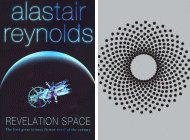 It wouldn't be fair to say the same of Revelation Space. Although it's the first in Reynolds's Inhibitor sequence, and sets up issues only resolved in later books, it stands effectively enough on its own. It does, however, feel, if not dated, then at least pale by comparison with his later books. The large-scale spaceship action owes an obvious debt to Iain M. Banks, but Reynolds has an interest in technological and scientific speculation Banks doesn't. The downside of this is that the multiple plotlines end up feeling too similar in their affect. The obsessive archaeologist delving into lost alien secrets and the obsessive starship crew with their insane captain and hideously destructive weapons feel interchangeable. And after the skill of Simmons and Priest, this book felt far less of a compulsive read.
It wouldn't be fair to say the same of Revelation Space. Although it's the first in Reynolds's Inhibitor sequence, and sets up issues only resolved in later books, it stands effectively enough on its own. It does, however, feel, if not dated, then at least pale by comparison with his later books. The large-scale spaceship action owes an obvious debt to Iain M. Banks, but Reynolds has an interest in technological and scientific speculation Banks doesn't. The downside of this is that the multiple plotlines end up feeling too similar in their affect. The obsessive archaeologist delving into lost alien secrets and the obsessive starship crew with their insane captain and hideously destructive weapons feel interchangeable. And after the skill of Simmons and Priest, this book felt far less of a compulsive read.
In a sense, Reynolds's book should be seen here as emblematic of what other British writers have been doing recently: taking the props of American SF and putting a distinctive dark perspective on them. (The zenith of this so far is M. John Harrison's Light (2002), a future classic if ever I saw one.) The end of the book opens up the sort of cosmological perspectives one associates with Stapledon (or Baxter), but does so in a story where individual actions make a difference. The reader can be excused for thinking she's been messed around on the way to these revelations: in a book this length, the slow drip-feed of information about the central mysteries can seem arbitrary, a device to prolong tension. As a general point, these Future Classics are very much longer than the Golden Age books I've been reviewing before, scarcely any of which are over 300 pages. The Reynolds is just the extreme example here of a more general trend: the books that you feel are somehow too long, which confuse word-length with scope. Put it like this: you read The Stars my Destination, The Three Stigmata of Palmer Eldritch or Fahrenheit 451, and you wish the story would go on longer. How many contemporary books can you say the same of? You may want to hear more about the world, but that's different.
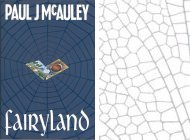 I wish I could hear more about the story and the world of the last Future Classic. Paul J. McAuley's Fairyland (1995) is, along with Blood Music and Evolution, the strongest of these reissues. Its premise sounds rather familiar: we're in a near-future Europe, and the book is mainly about the effects that genetic engineering has. However, the execution is anything but familiar. Early on, the book notes that, "Organic synthesis is still a black art resembling alchemy, in that operations have to be conducted in an exact and precise way that approaches ritualization, often for complicated reasons that are difficult to fully figure out." In other words, beyond a certain point, science starts to resemble magic. As the book goes on, the metaphorical or fantasy ideas keep becoming literal: there is, for instance, a genuine caste of fairies here, but created through scientific means. McAuley also has all sorts of ironic fun with that other venue of fantastic tales, (Euro-) Disneyland.
I wish I could hear more about the story and the world of the last Future Classic. Paul J. McAuley's Fairyland (1995) is, along with Blood Music and Evolution, the strongest of these reissues. Its premise sounds rather familiar: we're in a near-future Europe, and the book is mainly about the effects that genetic engineering has. However, the execution is anything but familiar. Early on, the book notes that, "Organic synthesis is still a black art resembling alchemy, in that operations have to be conducted in an exact and precise way that approaches ritualization, often for complicated reasons that are difficult to fully figure out." In other words, beyond a certain point, science starts to resemble magic. As the book goes on, the metaphorical or fantasy ideas keep becoming literal: there is, for instance, a genuine caste of fairies here, but created through scientific means. McAuley also has all sorts of ironic fun with that other venue of fantastic tales, (Euro-) Disneyland.
None of this would work so well, though, if it weren't rooted in a believable starting-point. The novel's first chapters are set in a grimly realistic London, plagued by terrorist bombings and too chaotic for anyone to care who really set them off. Having this as his root-note enables McAuley to spin his baroque fantasies later on far more freely. And unlike, say, the Egan, his scientific speculation is integrated into the narrative: he tells us enough to get by, but not so much that we feel trapped in a corner with a biochemistry lecturer.
In fact, having started out by wondering whether any of these novels would feel dated, I have to say that the McAuley feels more contemporary than many books published in 2007. That's not just because it taps into the pervasive anxieties about terrorism or biotech. It's more to do with its willing acceptance of chaos, a world in which politics, technology, and the personal are irretrievably mixed together. Despite the title, science offers no magic fixes, just new guises for the human condition. A present classic.
There's one leap of the imagination that's especially difficult for me to make in assessing these books. How would they seem to a non-SF fan picking them up as a first genre purchase? (That's evidently Gollancz's intention for this series, though I think the over-designed, no-rocketships-here covers will be a hindrance.) With Schild's Ladder, as I've said, I think the density and specialisation of the argument may be too much for the lay reader. But I'm too far gone as an SF reader (as, I'm sure, are most Locus readers) to unlearn that part of me. My guess is that most of them will travel pretty well, though I'm worried that a book like the McAuley, arguably the "best" as a piece of all-round SF may be too rooted in revising past works to make as much sense outside our field. The Simmons probably is both accessible and (in its full series form) destined to be a part of SF's canon. I'm less sure about the durability of the Morgan and the Reynolds; both authors have done more complex work later in their careers. I would like to think that the Priest and the Baxter will last, though both are odd books, even for SF. Of all eight, though, I guess the Morgan is most accessible, not least because its influences are most cinematic. But this sort of prediction is a mug's game: the SF virus continues to mutate and you can never tell which iteration will be catching.
Graham Sleight was born in 1972 and lives in London, UK. He has written reviews and essays on science fiction and fantasy for The New York Review of Science Fiction, Foundation, Interzone, SF Studies, SF Weekly, Infinity Plus, Strange Horizons, Vector, and Locus Magazine. He's served as a judge for the Arthur C. Clarke Award for 2005 and 2006, and becomes editor of Foundation from the end of 2007.
Graham Sleight is one of eight regular Locus reviewers. Every issue, we review dozens of new books and magazines, most before they appear in print. A subscription will get you all those as well as the rest of the magazine -- news, People & Publishing, commentary, reports on events, and a list of all books and magazines published that month.



4 Comments:
Fascinating stuff as always, Graham!
I agree almost down the line with you on the books. (My comment on The Separation when it came out was "He's palming about six million [12 million really!] cards.") I agree particularly about Schild's Ladder -- and indeed what a strange choice among Egan's novels. Though to be fair Egan's best work is all at shorter lengths.
--
Rich
Theres a Obvious but not talked about Link between Reynolds very interesting but not under total control,Revelation Space book and its Mentor, Hyperion.
To which Reynolds pays homage to several times within his epic.
I found it odd the Writer of this article Did not pick up on it.
Also you never Judge the Greatness of Hyperion by not including the second book. Which was published in half because of its Length.
Also not to see the Influence the book has already had, From the Matrix to funny enough, Revelation
Space is surprising.
Quite enjoyed the article and agree that Harrison's Light is a future classic. Reading these comments, I couldn't help but wonder if sporadic Milnean Capitals are making a Comeback as a RhetorIcal Style.
I hope you already consider "Peter F. Hamilton" and his "Nights Dawn Trilogy" a contemporary classic :-)
Post a Comment
<< Home